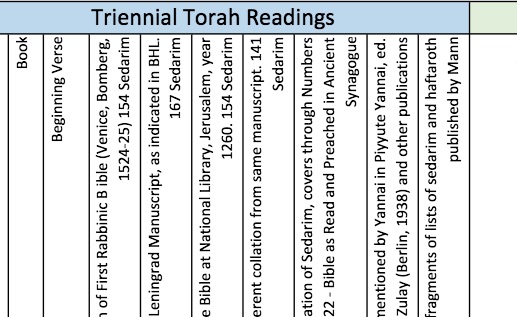 The Hebrew Scriptures were not always divided into chapters and verses; in fact it is not even of Jewish origin (Ginsburg, 1966). The chapter divisions that we are familiar with, according to Moore (1893) date back to “the Latin Bible in the thirteenth century ” (p. 73). Stephen Langton, the Archbishop of Canterbury (c. 1150 – July 9, 1228) is the one credited with devising the “chapter” system that has come down to us in our modern editions of the Bible. These chapter divisions are quite familiar and even helpful to students of Scripture, but do they assist the student in rightly dividing the word? They reflect at times a random break in the texts, often in places that interrupt the designed flow of narrative. So while they provide a common way of marking passages facilitating ease of reference, do they help us or hurt us in our understanding of Scripture? Is there a better method of dividing the texts than the system credited to Archbishop Langton? The answer is yes.
The Hebrew Scriptures were not always divided into chapters and verses; in fact it is not even of Jewish origin (Ginsburg, 1966). The chapter divisions that we are familiar with, according to Moore (1893) date back to “the Latin Bible in the thirteenth century ” (p. 73). Stephen Langton, the Archbishop of Canterbury (c. 1150 – July 9, 1228) is the one credited with devising the “chapter” system that has come down to us in our modern editions of the Bible. These chapter divisions are quite familiar and even helpful to students of Scripture, but do they assist the student in rightly dividing the word? They reflect at times a random break in the texts, often in places that interrupt the designed flow of narrative. So while they provide a common way of marking passages facilitating ease of reference, do they help us or hurt us in our understanding of Scripture? Is there a better method of dividing the texts than the system credited to Archbishop Langton? The answer is yes.
Ancient Hebrew Bible manuscripts followed a system preserved by the Massoretes, a school of rabbinic scribes of the 6th through the 10th centuries. When Jacob ben Chayim published his Rabbinic Bible (1524-25) he used the Christian chapters contained in R. Nathan’s Hebrew Concordance. Late in the publication of his work he discovered a list of the more ancient Massoretic divisions, but since he had come upon it as the work went to press, he had to publish it separately. In his introduction, he informs the reader that had he found it sooner he would have used it instead of the Christian chapters (Ginsburg, 1966). He says, “I have published it separately so that it may not be lost in Israel.” What were those ancient divisions?
The ancient divisions of the texts referred to by Jacob ben Chayim are known as sedarim. The sedarim according to early sources mark a very ancient division of the texts. A “seder” was read and taught every Sabbath and according to this ancient practice the Torah would be read through in approximately three to three and one half years. This “triennial cycle” was used in “Palestine” (Meg. 29b) whereas in Babylon the Jews read through the entire Torah in one year.
We possess several sources and lists of these sedarim. The precise number for these sedarim vary from 141 to 175. The Leningrad Codex for example marks 167 sedarim in the Torah. Since this is the oldest “complete” copy of the Hebrew Bible, I prefer this list but I have carefully made note of sedarim from other lists and manuscripts. Each of these would be the start of a weekly Torah portion. I am listing them here with the familiar chapter and verse location so that you can mark them in your Bible.
Genesis – 45 Sedarim
1.1; 2.4; 3.22; 5.1; 6.9; 8.1; 8.15; 9.18; 11.1; 12.1; 14.1; 15.1; 16.1; 17.1; 18.1; 19.1; 20.1; 21.1; 22.1; 24.1; 24.42; 25.1; 25.19; 27.1; 27.28; 28.10; 29.31; 30.22; 31.3; 32.4; 33.18; 35.9; 37.1; 38.1; 39.1; 40.1; 41.1; 41.38; 42.18; 43.14; 44.18; 46.28; 48.1; 49.1; 49.27
Exodus – 33 Sedarim
1.1; 2.1; 3.1; 4.18; 6.2; 7.8; 8.16; 10.1; 11.1; 12.29; 13.1; 14.15; 16.4; 16.28; 18.1; 19.6; 21.1; 22.24; 23.20; 25.1; 26.1; 26.31; 27.20; 29.1; 30.1; 31.1; 32.15; 34.1; 34.27; 35.30; 37.1; 38.21; 39.33
Leviticus – 25 Sedarim
1.1; 4.1; 5.1; 6.12; 8.1; 10.8; 11.1; 12.1; 13.29; 14.1; 14.33; 15.1; 15.25; 17.1; 18.1; 19.1; 19.23; 21.1; 22.17; 23.9; 24.1; 25.14; 25.35; 26.3; 27.2
Numbers – 33 Sedarim
1.1; 2.1; 3.1; 4.17; 5.11; 6.1; 6.22; 7.48; 8.1; 10.1; 11.16; 11.23; 13.1; 14.11; 15.1; 16.1; 17.16; 19.1; 20.14; 22.2; 23.10; 25.1; 25.10; 26.52; 27.15; 28.26; 30.2; 31.1; 31.25; 32.1; 33.1; 34.1; 35.9
Deuteronomy – 31 Sedarim
1.1; 2.1; 2.31; 3.23; 4.25; 4.41; 6.4; 7.12; 9.1; 10.1; 11.10; 12.20; 13.2; 14.1; 15.7; 16.18; 17.14; 18.14; 20.10; 21.10; 22.6; 23.10; 23.22; 24.19; 26.1; 28.1; 29.9; 30.11; 31.14; 32.1; 33.1
So based upon the divisions above, one would study Genesis 1.1 – 2.3 in the first week of the Torah cycle, 2.4 – 3.21 in the second week etc.
A careful look at the list of sedarim above will show that they often coincide with verse 1 in a “chapter,” but there are many examples where this is not the case.
Perhaps we should study our bibles according to the ancient divisions of texts recorded in the preserved notes and markings contained in the Hebrew texts. By doing so, would we not be rightly dividing the word of truth? By making people aware of this ancient system of sedarim we are doing our part to ensure that it is not lost in Israel!
References
Ginsburg, C.D. (1966). Introduction to the massoretico-critical edition of the Hebrew Bible. New York, NY: KTAV Publishing House .
Moore, G.F. (1893). The Vulgate chapters and numbered verses in the Hebrew Bible. Journal of Biblical Literature, 12(1), 73-78.
Triennial Torah Reading Chart (Genesis)



